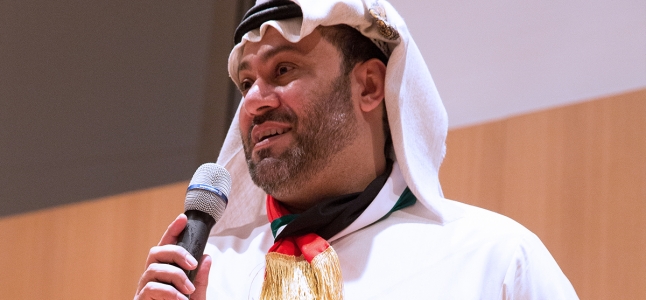I was in the United Arab Emirates recently to talk to assistant minister of justice Abdulla Al-Majid. He is, as far as I know, the only person of that rank in any ministry of justice who carries the title chief innovation officer. That is a worrying conclusion. Data tells us that justice systems all over the world are underperforming. We also see that they are not solving the problem with more ‘business as usual’. So why aren’t there more of his kind?
As a person Abdulla is hard to equal in terms of vision, drive, and courage. He will not rest until the justice system of the UAE does even better. And it is. In a conversation we had a while ago I understood more of what drives him. He told me the story of his grandfather. “He’d be away for weeks at a time. Travelling to the villages and wadi’s. They knew he was coming. He’d stay there to deal with all the disputes people where having. “. He calls it “Justice coming to you.” Accessible. Easy to understand. Effective.
Abdulla Al-Majid’s mission is exactly the same. Justice coming to you, using the wisdom of his grandfather and technology. That wisdom is captured by what psychology, social science, behavioural economy, and neurology are teaching us about how people chose, resolve disputes, comply with rules, and experience fairness. Easy-to-use digital technology harnesses that wisdom and disseminates it to citizens.
Abdulla and others are helping me understand what a chief innovation officer of a ministry of justice should do. I am not finished with my thinking yet, but here’s my first stab at a job description. Comments welcome. When we have something good enough, I suggest we all push the remaining 194 ministries of justice of the world to appoint one by 1 January 2019.
Let’s start with what the chief innovation officer of a ministry of justice must produce. I’d say: measurably better justice delivery for citizens. Justice coming to you. Accessible, easy to understand, and effective. Justice delivery that gets better, year after year. Just like the health sector annually produces better health treatments and more access.
What about asking him/her to help produce better tools to measure whether justice outcomes are being achieved? For most ministries of justice and judiciaries, success is producing enough judicial decisions per year, delivering them in time, being adequately staffed, and staying within budget. It needs to be more about outcomes. How much violence is prevented? How many employers and employees have been able to make smooth transitions to new work when a contract was terminated? How many former spouses have been able to transition to happy new lives after their relationship ended? When there is more clarity on outcomes it becomes clear where innovation is needed.
What else can he/she deliver? What about a one-stop-shop access to justice route for employers and employees, supported online? Smart do-it-yourself platforms that help SMEs inexpensively organise the legal infrastructure they require? A block-chain based virtual reality system to execute a will at home? Smart protocols containing best practices for dealing with family, land, and neighbour disputes? Or online dispute resolution mechanisms that seamlessly connect informal justice mechanisms with courts. He/she’d help build them and scale them up.
What does the role require? Our chief innovation officer must be an excellent convener, connector, and collaborator. He/she must be able to set-up, drive, and facilitate processes, because that is what innovation is. His/her role is not being the inventor, but rather the one who turns almost everybody he/she works with into a justice inventor and entrepreneur. He/she must also able to force something through if needed. Both the convening role and the ability to be able force through if needed would dictate that the post be ranked at the level of assistant minister or at a minimum that of director general.
Breaking down barriers will be an important part of the work. There are many of them. Between the departments within the ministry of justice. Between the ministry of justice and the ministries of interior, social affairs, health, education, finance, and economic affairs. And then there is the outside world: the bar association, the private sector, universities, think tanks, and civil society organisations. Each of these will generally have a contribution to make to a justice innovation. But they all like to stay in their own worlds.
The function also needs a serious budget. You must be able to convene people and to commission research about what users experience and need. You’ll need some seed money to spend. The budget should have some built-in freedom. Innovation is about trying, with enough room to try something fail, learn, and try again. He/she does not have to be a lawyer. In fact, not being one can be an advantage: you can ask all the stupid questions that nobody asked before. He/she must be creative. A servant leader, whose ego does not get in the way of things. A window to what is being done in other countries is also important: justice systems have more in common than is sometimes thought. We can learn from each other.
In today’s world, a chief innovation officer of a ministry of justice must also be able to work with data. In fact, his/her default mode of working must be evidence based. It would also be good if he/she was somewhat familiar with business model thinking because most innovations require creative and smart ‘deals’ between legitimacy givers, implementers, funders, and knowledge bringers to work.
What am I missing? Let me know. With your additions I’ll try to develop a job description format we can all use and push. I’m sure Assistant Minister Al Majid will be happy to help.
This article was originally published on Slaw.ca on 23 July 2018.



